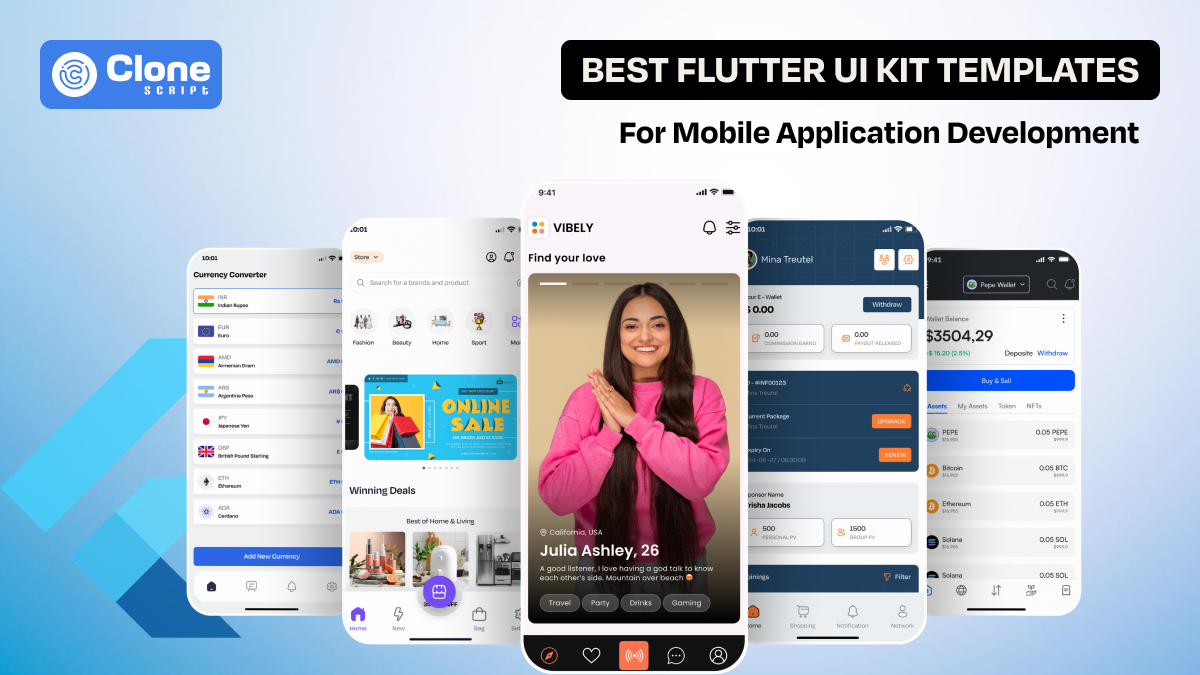7 Steps to Launch Your Mobile Application Successfully
Every business is now being online and selling its products with the help of advanced technology. One of the most important and emerging technologies is the “mobile application.” Launching a mobile app can be a great tool for interacting with customers directly.
The intention of choosing mobile apps over the website is to stand out from the competition and retain the user's engagement rate. However, it’s never going to be easy due to high competitive app marketplace. To successfully launch your mobile app you have to stick with a certain kind of strategy that helps draw attention and establish a reputation.
The ultimate goal of your new app launch is to reduce the abandonment rate. Conversely, you prioritize increasing the user engagement rate and daily app usage.
In this article, we mention the core 6 steps you have to follow to make the app launching successful and achieve the objectives. But don’t forget to remain flexible for future trends and changes in customer preferences. Your app launch strategy should comply with the industry standards.
Step 1: Understanding Your Audience
Knowing your ideal customer is the first step in a successful app launch. If you fail to do that, don’t expect the better results you want.
You have to invest time and money to conduct research about what the users are currently using and which problems prevent them from reducing their app usage. This will clarify which aspects you have to focus on and design the product accordingly.
"Using AI-driven behavioral analytics, app developers can gain insights into how users interact with their app in real-time, allowing for dynamic adjustments and personalized experiences."
Meanwhile, a deep analysis of each user’s demographics, behaviors, and income level helps you how to represent your app for a better engagement rate. This kind of market research is not only for app development but also guides you to perfect app marketing. For example, from visual representation to social media marketing and content marketing to SEO.
However, if you have thousands to millions of users' data it’s tough to identify each user's interests and dislikes. Here, the user segment and persona creation work as a boon.
To create a user persona you have to include these aspects:
-
Demographic Information: Age, Gender, Location, Occupation, Education Level, Income Level.
-
Psychographic Information: Goals, Values, Lifestyle, Personality, Pain Points.
-
Behavioral Information: Usage Patterns, Device Preferences, App Preferences, Tech Savvy.
-
Goals and Challenges: Primary Goals, Secondary Goals, Challenges.
Read Sports Betting Futuristic Trends of 2024 to Keep an Eye On.
Step 2: Identify and Represent your Unique Value Proposition (USP)
After conducting the market and user research, move to another important step called USP acknowledgment. Discuss it with your team members and gather some feedback that will help you to create a complete strategy for defining USP.
Launching the mobile app on Google Play Store and Apple Store does not mean you get thousands of downloads until you identify and represent your product’s USP. As millions of apps already exist online, you have to stand out.
-
Competitor analysis
Don’t be involved in a copycat approach that can bring down your app’s credibility. Meanwhile, you can take the idea from the already available apps from competitor analysis. This can be helpful to a SWOT analysis of which kind of strengths, weaknesses, opportunities, and threats your product has.
-
Unique design preference and monetization model
From that, you can easily understand which aspects you have to work for whether it’s app UI and UX designing or in-app purchase integration. In addition, you can reduce the chances of product failure and prevent any misconfiguration before starting the app development.
Keep note: Don’t try to differentiate yourself from the competition. Before your app hits the marker, users are familiar with other apps. You have to focus on how your product can be helpful for them over other apps.
Step 3: Develop a Comprehensive Business Plan
The third step for launching a mobile application having a well-defined business plan. It's just like skydiving with a parachute.
A comprehensive business plan not only guides the development process but also ensures that you stay focused on your objectives, manage resources efficiently, and measure progress effectively.
Here’s how to develop a strategic but flexible business plan for your mobile app:
-
Outline Your Goals
Setting clear goals is essential for guiding your app's development and growth. Short-term objectives might include completing the MVP and reaching initial user targets. While long-term goals could involve scaling the user base and achieving profitability.
These goals should be SMART - Specific, Measurable, Achievable, Relevant, and Time-bound to ensure they provide a clear direction and measurable success.
-
Plan Your Budget
A well-structured budget is crucial for managing your app’s financial health. Include costs for development (design and coding), marketing (advertising and promotions), and operations (server costs and support).
Accurate budgeting helps prevent overspending and ensures you allocate resources efficiently. Don’t try to stick with only a single-faceted budget, be flexible too to avoid any misconfiguration.
-
Set Milestones
Defining key milestones helps track progress and stay on schedule. Clearly outline development stages such as completing design and coding phases, as well as launch activities like app store submissions and marketing campaigns.
While keeping focus on post-launch milestones like user feedback and engagement metrics, guide future improvements and growth strategies. Regularly reviewing and adjusting these milestones based on performance data ensures that your app evolves in line with market demands.
Read How to Launch Meme Coin on Solana with Perfection for Better Presence.
Step 4: Build and Test an Actual App With a Minimum Viable Product (MVP)
After completing the first three steps, the fourth step is to start the front-end mobile app development. After that, integrating the app with the backend system will deliver enhanced security and easy data management. You have to use cutting-edge technologies and frameworks to complete the development quickly with all essential features.
Creating the Minimum Viable Product for the new product version is the fourth step of the app launch. MVP is a replica of the original product concept that almost has features and aligns with the basic needs of early adopters.
The goal of an MVP is to test the product's viability in the market with minimal resources and development time. This approach helps reduce risk and avoid investing heavily in features that may not resonate with users.
-
Prioritize features
When developing a mobile app, it’s crucial to focus on essential features that highlight your product’s core value. Also, design the MVP according to it.
Prioritize functions that solve your target audience’s primary pain points and deliver the key benefits your app promises. With this, you can launch quickly and cost-effectively while providing enough functionality to attract and engage early adopters.
-
Develop the MVP
The MVP should be functional enough to validate your concept and gather user feedback but does not need to be fully polished. This streamlined approach allows you to test assumptions and make data-driven decisions before investing heavily in additional features or enhancements.
-
Conduct Usability Testing
QA & Testing is a very essential phase of successful app launching. Through usability testing, you can refine your app and ensure a positive user experience. Engage real users to interact with your MVP and collect their feedback on functionality, ease of use, and overall satisfaction.
This process helps identify pain points and areas for improvement, enabling you to make proper adjustments and enhancements based on actual user experiences before the full-scale launch.
Step 5: Create a Robust Marketing Strategy
Once you have your app and MVP ready and tested, it’s time to focus on marketing. A well-crafted and modern marketing strategy can make or break your app’s success.
Here's how to develop an effective marketing plan:
-
Pre-Launch Buzz
Build anticipation for your app before its official release. Use teaser campaigns, create a landing page to capture early interest, and engage potential users through social media and email newsletters.
Consider offering early access or exclusive features to a select group of users to generate word-of-mouth and collect preliminary feedback. For that, you can set up social media accounts to draw millions of users from around the world.
-
App Store Optimization (ASO)
Optimize your app’s listing on app stores to improve visibility. This includes creating a compelling app title, using relevant keywords, writing an engaging app description, and creating eye-catching screenshots and videos.
Having positive reviews and ratings on app usage also plays a crucial role, so encourage satisfied users to leave feedback.
-
Paid Advertising
Leverage targeted advertising to reach your audience effectively. Platforms like Google Ads, Facebook Ads, X (Formerly Twitter) Ads, and Instagram Ads offer sophisticated targeting options to help you reach potential users based on demographics, interests, and behaviors.
In addition, paid social media ads can be a good option to represent your app for millions of users and influence them to download it with an interesting message and visual elements.
-
Influencer Partnerships
Instagram and YouTube are hot choices online platforms to market your newly launched app. You have to collaborate with the industry expert influencers or bloggers who align with your app’s target audience. They can provide authentic reviews and help expand your app’s reach through their established networks.
Read How to Improve Sportsbook User Experience for Best Functioning.
Step 6: Launch and Monitor Your App
The sixth step is the favorite of any mobile application developer to see live the app on the web. With the marketing strategy in place, it’s time for the official launch.
However, launching the app is just the beginning.
Effective monitoring and management are important for long-term success:
-
Soft launch
Consider a soft launch in a smaller, controlled market to gather initial feedback and make necessary adjustments before a full-scale launch. This approach allows you to identify and fix potential issues without impacting a broader audience.
-
Address issues quickly
Be prepared to address any issues or bugs reported by users promptly. Effective customer support and timely updates are essential to maintaining a positive user experience and encouraging continued engagement.
-
App store(s) submission
When you’ve completely addressed and solved the issues in the app, make it ready to launch on the app store (s). Keep the focus on the submission guidelines for the Google Play Store and Apple Store. Make sure you follow the guidelines to remove the chances of rejection.
-
Gather User Feedback
Continuously collect and analyze user feedback to understand their needs and preferences. Use this information to guide future updates and improvements, ensuring that your app evolves in response to user expectations.
-
Monitor performance metrics
Keep a close eye on key performance indicators (KPIs) such as user acquisition, retention rates, and in-app engagement. Utilize analytics tools to track user behavior, identify trends, and understand how users interact with your app.
Step 7: Plan for Post-Launch Growth and Updates
Last but not least step of mobile app launch is related to future updates. Don’t think once your app is live it will always remain better. As time goes on and new trends are adopted by the users, your app is also designed with that.
To sustain growth and keep users engaged, focus on ongoing improvements and strategic planning:
-
Feature Updates
Regularly release updates to introduce new features, enhance existing functionality, and fix bugs you reported before. This demonstrates that you’re committed to improving the app and responding to user needs.
-
Engagement Strategies
Implement strategies to keep users engaged, such as push notifications, personalized content, and loyalty programs. Regularly communicate with users through in-app messages or email newsletters to keep them informed about new features and promotions.
-
Analyze Market Trends
Stay updated on industry trends and competitor developments to ensure your app remains relevant and competitive. Adapt your strategy based on market changes and emerging technologies to continue meeting user expectations.
-
Expand Marketing Efforts
As your app gains traction, consider scaling your marketing efforts. Explore additional channels such as content marketing, partnerships, and international expansion to reach new audiences and drive continued growth.
Read Why to Choose WordPress Meme Coin Theme for Your New Crypto Project Website Launch.
All Clone Script’s Complete Solution From App Designing to Post-Launch
All Clone Script is the best mobile application development company. From app designing to managing its post-launch, we cover each stage with an agile and flexible approach.
Most importantly we provide our services to every business from e-commerce to online restaurants and meme coin launches to real estate.
You can check out our mentioned clone scripts for the different business segments, so you can understand why we’re the best choice for your custom requirements.
If you like to make a Tattoo Booking Mobile app or Online Beauty & Cosmetic Store App, you can purchase it and start your entrepreneurial journey.
Moreover, if you have unique needs for application development and like to talk with us, don’t hesitate to send your message. Just tap the contact us and fill in the requirements regarding your preference. Once we receive your message, we will back to you with a tailored solution.
Conclusion
Everyone loves to have their mobile applications available online and cater to millions of users to drive a profitable business. However, launching a mobile app needs to follow the steps mentioned above.
If you’re a mobile app developer or just a business owner looking for an app development solution, this article ideally guides you.
Meanwhile, you have to always keep understanding the future trends being introduced to the world and modify the application according to that. Most importantly, consider the user’s interests and in-app purchases integration to make the application useful and successful.
 BTC - Bitcoin
BTC - Bitcoin
 USDTERC20 - USDT ERC20
USDTERC20 - USDT ERC20
 ETH - Ethereum
ETH - Ethereum
 BNB - Binance
BNB - Binance
 BCH - Bitcoin Cash
BCH - Bitcoin Cash
 DOGE - Dogecoin
DOGE - Dogecoin
 TRX - TRON
TRX - TRON
 USDTTRC20 - USD TRC20
USDTTRC20 - USD TRC20
 LTC - LiteCoin
LTC - LiteCoin







